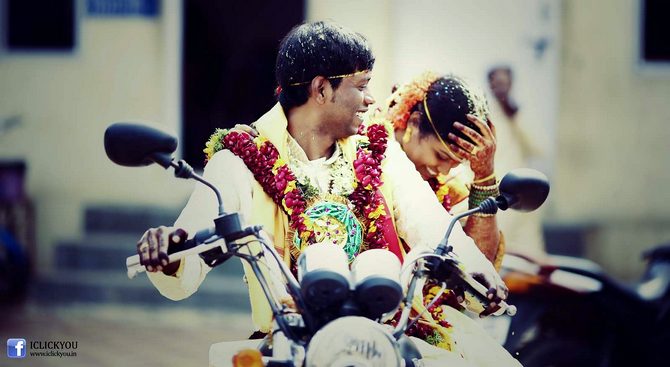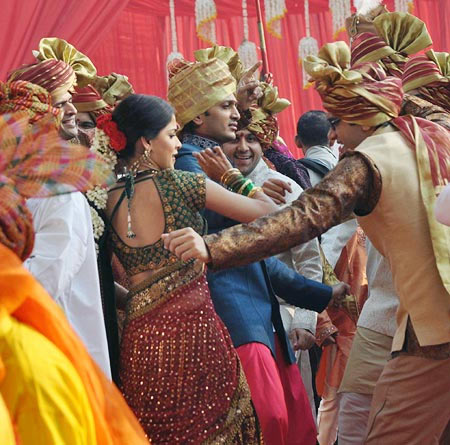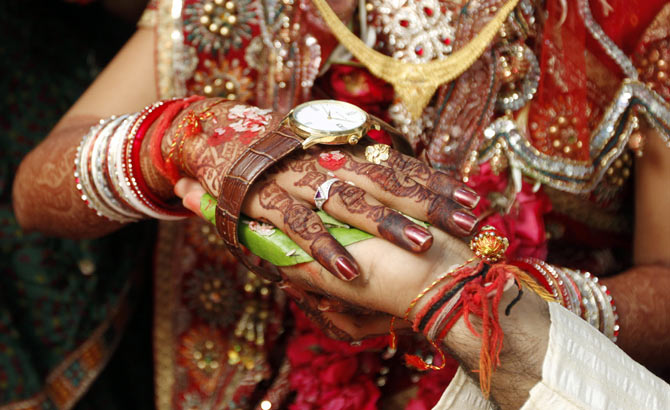 | « Back to article | Print this article |
Want to improve your marriage prospects? Get an MBA!
'At a meeting with a director of a business school, I told him there are over 3,000 business schools producing some four to six lakh MBA graduates a year. Industry cannot absorb so many MBAs, even if the economy grows at 9% a year.'
'If this is the case, why spend lakhs to send your son or daughter to a business school, I wondered.'
'He explained I had missed the point.'
'Getting your son or daughter through business school improves their rate in the marriage market.'
'The boy can command a better dowry; and the girl can get a simple job, maybe find a boy and bring down the dowry rate.'
Ambi Parameswaran decodes The Big Fat Indian Wedding.
By all means marry; if you get a good wife, you'll become happy; if you get a bad one, you'll become a philosopher. -- Socrates (469-399 BCE)
"The coming year (2009) is a good year for weddings, we expect sentiment to improve and sales to pick up," said Aniruddha Deshmukh, president of Raymond, India's largest brand of men's formal clothing.
I was a little surprised, and asked him to explain. He elaborated, "A significant part of our sales comes from weddings, not just for the bridegroom, but we have also seen at least another ten men get new suits made for each wedding. Last year was a little dull by both the Hindu and Christian calendars. It was a leap year."
What have weddings got to do with a leap year?
Leap years were the creation of Julius Caesar in the first century BCE to synchronize the calendar with the seasons.
It was left to Pope Gregory XII to perfect the system in 1582, and hence the name Gregorian calendar that continues to be used till date.
Unfortunately, the new changes were accompanied by a set of superstitions.
 Romans and Greeks were superstitious about starting any new personal or professional relationship in a leap year.
Romans and Greeks were superstitious about starting any new personal or professional relationship in a leap year.
Even in Ukraine, where every day has been assigned to a saint, a leap year is seen as unlucky for marriages.
Myth has it that Cassian, who is assigned 29 February, refused to help a peasant whose cart was stuck in the mud.
St Nicholas came to the poor farmer's aid, giving god sufficient reason to grant St Nicholas two days a year and banishing Cassian to just one day every four years.
This aggravated Cassian, who vengefully brings sickness and ill health every time he appears, every leap year.
As per the Hindu calendar too, there are 'good years' with a large number of muhurats and some not so good years with fewer muhurats. The Chennai jeweller GRT Thanga Maligai distributes calendars earmarking good wedding dates.
According to the calendar, there are only ninety-one auspicious wedding dates in 2013. Hindu wedding dates are spread almost evenly through the year except for a month or two, depending on the region you are coming from.
For instance, in Tamil Nadu marriages don't take place in Aadi (15 June to 15 July) and Margazi (15 December to 15 January).
Muslim weddings occur throughout the year, the only probable exception being Muharram, in the first month of the Muslim year, as it was the day Prophet Muhammad's grandson Hussein and others were killed.
During Ramadan, the month of fasting, giving and abstinence, weddings are allowed but the celebrations are expected to be muted. For Christians, Lent is not considered a good period to get married.
The six weeks or forty days leading up to Easter Sunday are earmarked for prayer, penance, repentance, charity and self-denial.
In addition, there are real dampeners like the monsoon. Ashada, one of the two inauspicious months in the Hindu calendar, conveniently falls during the monsoon, though it is difficult to say if this was wisely planned or accidental good fortune.
All said and done, The Big Fat Indian Wedding is our biggest celebration and indulgence and no wedding is complete without a strong dose of religiosity.
As Jawaharlal Nehru observed while presenting the Hindu Code Bill in Parliament in 1955, 'Hindu marriage is a religious ceremony undoubtedly, nobody doubts that. It has religious significance.'
Note: All photographs and illustration used only for illustration purposes
Excerpted with permission from the author and Penguin Books India from For God's Sake: An Adman On The Business Of Religion by Ambi Parameswaran Price: Rs 499.
Please click HERE to buy the book!
Kindly click NEXT to read more...
Bollywood stars have woken up to this new market
A report in the Hindustan Times (1 April 2013) pegs the size of the wedding industry at Rs 1.5 lakh crore. Given the size of India's grey economy, the real figure could far exceed any official estimate.
Expenditure on weddings encompasses attire, jewellery, wedding events (puja, cuisine, decoration, entertainment, etc.) as well as travel/hotels/transport and other associated costs (not to mention the products bought as wedding gifts which could include cars, homes and consumer durables).
The report indicates that 10 per cent of Indian weddings are planned to accommodate over a thousand guests! South Indians are notorious for hosting a large number of guests while North Indians prefer to stage special events.
Several kalyana mandapams dot Chennai, many of them set up by industrial and filmi families, each with a capacity to accommodate thousands of guests.
The phenomenon of venues identified solely for weddings is perhaps unique to South India.
In the rest of India, community halls, school playgrounds or even farmhouses double up as wedding venues. The concept of boutique designer weddings hosted for just a few hundred select families has not yet found many takers in South India, given the proclivity for large-scale weddings in the region.
The Event and Experience Marketing Association of India (EEMA) has recognised marriages as a legitimate event category in their annual awards, along with other categories like product launch, exhibition and rural activation.
I had the opportunity of serving as the chairman of the EEMA awards jury a few years ago and was rather surprised at the 'sub-categories' in the wedding category: below Rs 1 crore; Rs 1 to 5 crore; and above Rs 5 crore.
Each award entry was accompanied by a large photo album and DVDs as proof of their efforts.
There are event management companies that specialise only in wedding planning. And if you look around your own colony you will find a few young wedding planners, the type presented in the Bollywood hit Band Baaja Baaraat.
Brands have tried to use weddings to stimulate sales, bond with their customers and build empathy.
Godrej Storwel has made some memorable ads -- in one, the entry of the bride into her new home (Saajan ke aangan mein pehla kadam, the bride's first step in her in-laws' place is auspicious) is portrayed in the context of the new Godrej Storwel joining her new family.
Bajaj has shown a newly married couple driving off on a scooter and so has Tata Indica.
Now we are seeing companies riding the wedding bandwagon in many new ways.
For instance, Malabar Jewellers has come out with a coffee table book called Brides of India.
These books present in great detail the jewellery needed to bedeck a bride.
There are sections for every conceivable community across religions. Malabar Jewellers has brought out two calendars and two volumes of Brides of India so far and my guess is that there are enough religious communities in India for them to continue with these books for the next ten years or more.
Let's swing to another industry that has received a wedding boost: The beauty industry.
No wedding was or is complete without a trip or several trips to the beauty parlour.
The growing affluence of Indians has opened up many new dimensions to this beauty craze.
The dermatologist has entered the arena with special packages for treatments like facial peels, something we saw only beauticians offering a few years ago.
I will not speak here about other surgical enhancements that are gaining ground. Often the beauticians will come to the bride's and groom's houses.
Of course, the beauty treatments are not just for the bride and the young but also other relatives, cutting across gender and ages, all of whom get facials, manicures, hair colouring and what have you.
Yet another area that has developed in the recent past is the concept of a destination wedding.
Places like Neemrana Fort in Rajasthan offer full packages for hosting weddings.
These events, all of which could fit into the top segment of the Wedding Category of the EEMA awards, target not only affluent Indians but also super-rich NRIs as well as Indophiles from Europe and the United States, including the glitterati.
Each of these weddings could cost a million dollars or more.
They are offered as a total package of three or four days of fun and frolic, each day with a different theme and entertainment programme.
Bollywood stars have woken up to this new market. Several are known to dance at weddings for obscene amounts of money, while others charge an 'appearance fee' just to walk in, get a few photographs clicked and walk out.
Excerpted with permission from the author and Penguin Books India from For God's Sake: An Adman On The Business Of Religion by Ambi Parameswaran Price: Rs 499.
Please click HERE to buy the book!
Kindly click NEXT to read more...
Horoscope matching continues to be a thriving business all over India, though the tenor may have changed
In this hyper-material world we live in, what have weddings got to do with religion?
We can see that religion determines the good and bad period for weddings.
According to the Hindustan Times report, 74 per cent of the young prefer an arranged marriage and over 90 per cent would seek parental consent.
We will see later how one key dimension of Indian religiosity is the need to stay connected to one's own community/religious group.
So the marriage arranging market continues to be vibrant, dominated by 'kundali comparing' astrologers.
Classified sections of newspapers now face competition from Web sites that offer specific matrimonial services.
In addition to these, there are matrimonial sites that cater to specific linguistic groups (gujaratimatrimony.com) and even divorcees (secondmarriage.com).
Besides, there are online wedding planning software and online end-to-end wedding organiSing services that provide a complete suite of services, from booking the venue and helping in the shopping to making arrangements for the honeymoon.
Then, there are e-commerce sites for wedding invitation cards and sites that link couples with the various service providers.
This is becoming all the more important as many couples may be working in remote locations and want to be fully in control of the event and not leave it to their ageing parents.
Horoscope matching continues to be a thriving business all over India, though the tenor may have changed over the last few decades.
From being a ritual that was the preserve of the upper castes, all classes of consumers seem to have adopted it with semi-trained roadside temple priests matching horoscopes as a lucrative side business.
According to ancient Hindu custom there are several types of weddings:
'Brahma wedding, where the daughter is given as a gift to a worthy scholar of the Vedas and of good character';
'Daiva wedding, which is like the Brahma wedding, but here the father of the bride is a priest';
'Arsa wedding, where the father of the bride receives a bull and a cow';
'Prajapatya wedding, where the proposal of marriage comes from the bridegroom';
'Asura wedding, where a wife is purchased';
'Gandharva wedding, where the couple marry for love, without parental consent';
'Rakasa wedding, where a man carries off his wife weeping from her home';
'Paisaca wedding, where a man has "secret sex" with a woman when she is sleeping or is inebriated'.
To these eight types of weddings, we can now add three more -- the sub-Rs 1 crore wedding, the Rs 1 to 5 crore wedding and the above Rs 5 crore wedding.
Hindu weddings are elaborate affairs consisting of several steps, all of which have been passed on for generations -- arghya, respectfulness, or showing hospitality (from the bride's father to the bridegroom);
kanyadana, giving away the virgin, or the formal gift of the daughter to the groom;
manalashta, eight blessings, offered by priests with a sheet suspended between the bride and groom (interestingly, the mangalsutra originated as a tali, a devadasi custom in South India);
kanthibandana, necklace-exchange;
panigrahana, hand-grasping;
asmarohana, stone-mounting;
homa, or the ceremonial fire;
Agni-pradikshina, fire circumambulation;
and finally, saptabadi, seven steps, where the bride and groom take seven steps before the fire.
Each step here symbolises a particular blessing -- food, strength, wealth, happiness, progeny, cattle and devotion.
Excerpted with permission from the author and Penguin Books India from For God's Sake: An Adman On The Business Of Religion by Ambi Parameswaran Price: Rs 499.
Please click HERE to buy the book!
Kindly click NEXT to read more...
Younger Indians are not averse to ritualistic practices, unlike a generation or two before them
Ethnographers are of the opinion that till Laws of Manu was written around 300 BCE (it is a matter of debate whether there was one Manu or a group of writers who gave the finishing touches to this magnum opus), marriages between castes and classes were quite common and there was no law prohibiting such relationships.
In fact, Aryan tribes thought nothing of marrying native Dravidian tribes -- this may explain why there are dark-skinned North Indians and fair-skinned South Indians.
But with Manu's laws becoming established practice by the advent of the Common Era, cross-marriages became extremely rare.
With the rapidly declining sex ratio in modern-day India, we see girls in big demand in states like Punjab, which have a very poor sex ratio.
In such states, there is no taboo on getting a bride from a lower caste or class, as long as she is from a distant state.
This trend may continue to grow in the coming decades because weddings are obviously critical for the long-term growth of a community and, in a perverse way, women will gain some respect in these male-dominated societies.
So, to start with, a traditional Hindu wedding is meant to be an elaborate affair, a trend that is regaining popularity with increasing affluence.
Weddings are growing in size and scale, across the country.
Customs like the sangeet are now common even in South India, where it was practically unknown.
I am sure practices such as the oonnjaal or the swing, where the bride and groom sit on a swing, will soon become part of the North Indian wedding.
These days, many weddings have a simultaneous translation service for the benefit of foreign guests and the younger generation who may not be familiar with the rituals.
In some cases, you even get a little booklet detailing the significance of each ritual.
I have noticed that younger Indians are not averse to these ritualistic practices, unlike a generation or two before them.
While the grandfather may have had objections to taking off his shirt and displaying his chest hair, the grandson today may be quite happy to show off his shaved chest and his five pectoral muscles.
That aside, there seems to be a latent admiration of these ancient customs, some that go back to Vedic times.
I suspect this is because Indians are now a lot more comfortable with their own religiosity and are not trying to hide it in the closet.
The Western world too has woken up to the fact that Hindu customs may not be 'pagan' after all.
In many ways, weddings are a key driver of demand, in several categories of products. Smart companies have understood this and factored it into their marketing plans. As we saw, they have made it an integral part of their consumer connect programmes.
The implications for you, whichever business you are in, are not difficult to conjure.
First of all, you need to see what weddings have to do with your business.
Do you know and do you track wedding seasons actively?
If not, does it make sense to track these dates?
And is it worth your while to plan special activities around weddings?
Chances are you understand the importance of weddings and are doing something about it.
If not, it's time you started looking at the charts and planning your next move.
Excerpted with permission from the author and Penguin Books India from For God's Sake: An Adman On The Business Of Religion by Ambi Parameswaran Price: Rs 499.
Please click HERE to buy the book!
Kindly click NEXT to read more...
The wedding market will continue to boom in India
Name the industry and chances are the wedding market will impact your business. I am not talking of just the jewellery or apparel or hotel and tourism businesses. Even consumer goods companies can exploit the market potential.
Food product companies can offer special packages to wedding caterers.
Amul can offer giant-sized condensed milk and butter packs that cater to the wedding market.
Soft drinks manufacturers too can offer special deals to ensure their product is distributed at the wedding.
If they pay to be the brand of choice at a movie chain -- Pepsi, for instance, is the beverage of choice at PVR Cinemas and has to pay what is known as 'pouring rights' fees -- I am sure they are also working on tying up with the biggest caterers in each big city. How about a durables retailer? Or a departmental store?
In the US, there is the brilliant concept of a wedding registry.
I have seen it only in one of the many wedding cards I have got in India.
This is how it works.
A newly married couple readies to set up home.
Given the cost of the many things needed and the fact that they are young and starting out in their careers, they look forward to receiving all the help they can get.
So, before the wedding they visit a few key departmental stores.
The store management offers to keep a 'register' for their wedding.
The couple indicates the products they would like from the store: It could be anything from linen to cutlery, furniture to appliances.
The invitation card mentions the store which has the wedding registry.
Invitees can go to the store and decide on the products they want to gift.
The store takes care of all the shipping and handling hassles and even provides a customised card with the gift.
Some stores also offer 'part gifting' where two invitees can contribute to the gift.
This way, friends and relatives buy a gift the couple can use and there is no danger of unwanted, duplicate gifts.
Wedding registry is a concept waiting to happen in India. I wonder why it is taking so long.
It is possible that affluent Indians have figured out an elegant way of handling unwanted gifts, by insisting on 'no gifts'. But this is killing a good selling opportunity.
At a meeting with a director of a business school, I discussed the issues facing second-rung and third-rung business schools.
I told him that there are over 3,000 business schools producing some four to six lakh MBA graduates a year. Industry cannot absorb so many MBAs, even if the economy grows at a fast clip of 9 per cent a year.
And not all MBAs go on to start their own business.
We agreed that but for the top 50 to 100 business schools, the other 2,900 do not impart any real management education.
If at all, MBA graduates from these business schools can only get jobs that can also go to an undergraduate with a bachelor's degree.
If this is the case, why spend lakhs to send your son or daughter to a business school, I wondered.
He explained that I had missed the point.
Getting your son or daughter through a business school improves their rate in the marriage market.
The boy can command a better dowry; and the girl can get a simple job, maybe find a boy and bring down the dowry rate.
I am sure most of these business schools are aware of this and may even be encouraging this trend.
So are business schools in the process of becoming matchmaking centres?
Many years ago, we worked on an IT training school based out of Singapore that was setting up shop in India.
We discovered that the attraction of an IT training centre depended more on which training school the best-looking girls went to and not so much on the quality of teaching.
Maybe, business schools have become an expensive replacement for the good old IT training centre.
Let me give you an even better example of an Indian businessman who has exploited the opportunity offered by weddings.
A wedding used to mean men in suits and women in saris. Not any more. Each wedding has several events, and each event has its own dress code.
So if the wedding and the reception calls for suits and saris, what about the sangeet ceremony?
Women wear designer ghagra-cholis and the men need to wear something equally appropriate.
Enter the men's designer kurta-churidar.
Every Indian town has seen the mushrooming of male ethnic wear shops, just as we have seen the growth of traditional sari shops.
Amid all this, a brand called Manyawar seems to have managed to build tremendous traction, selling over Rs 500 crore worth of goods in 2012.
Only a handful of men's ready-made garment brands have sales of this magnitude.
The surprising part is that Manyawar has managed to build such a huge base in just a few years.
Chances are that the wedding market will continue to boom in India with growing affluence.
There is already an acute scarcity of wedding venues in bigger cities and this will only get worse, opening up new opportunities for innovative venue options -- temples, school grounds, clubs, hotels... What next?
We had a British-born creative director some years ago. He and his parents are confirmed Indophiles. He married his Kiwi sweetheart at a theme wedding in Rajasthan, under the most auspicious circumstances. 'It was a wonderful wedding, but it turned out to be a lousy marriage,' he says now.
Amen to that.
Excerpted with permission from the author and Penguin Books India from For God's Sake: An Adman On The Business Of Religion by Ambi Parameswaran Price: Rs 499.
Please click HERE to buy the book!




